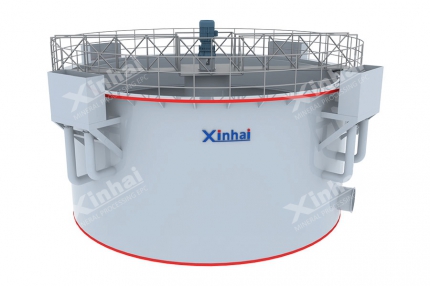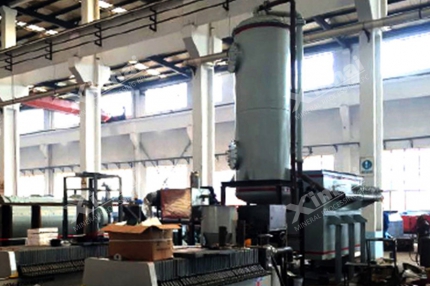As a precious metal resource, the gold resources are gradually decreasing, the high-grade gold mining has come to an end, and the refractory gold and the associated gold in other minerals have become the focus of gold mining and recovery. At present, the most common gold extraction method for this kind of gold mine is the gold cyanide leaching process. But do you know the factors affecting gold leaching in cyanide leaching process?
In the mineral processing tests for refractory gold ores, the mineral processing test personnel usually selects variables to test, such as grinding fineness, pulp pH value, pulp temperature, agitating speed, cyanide agent dosage, pulp density, leaching time, and inflating volume. The above variables are the major factors affecting gold ore leaching. In addition, there are other factors affecting gold ore leaching, such as associated impurities in ore, amount of leaching aid, etc., which are various due to the ore differences, so they are not discussed here. Then, we will explore the impact of the above factors on gold leaching.
Use the table of contents below to navigate through the guide:
01Grinding fineness affecting gold leaching
Generally speaking, the determination of grinding fineness is related to the ore dissemination characteristics. The grinding fineness is affected by the different ore dissemination characteristics, the size and morphology of gold particles.
Taking a gold mine as an example, the gold particle size of the gold mine is fine. The part of 0.037-0.01mm accounted for 56.32%, and that of less than 0.01mm accounted for 36.80%, which was embedded in various minerals as the intergranular condition.
After carrying out tests on the -0.074mm content of 70%, 75%, 80%, 85% and 90% respectively, the mineral processing test personnel found that:
● When the part of -0.074mm accounted for 85%, the recovery rate of gold is good;
● When one-stage grinding fineness was increased from 70% to 85%, the recovery rate of gold was increased from 82%-85% to 91.0%.

For different gold ores, the grinding fineness should be determined through mineral processing test, and it has a direct influence on the final recovery rate of gold ores.
02Pulp pH value, pulp temperature and agitating speed
The reason why the pH value of pulp, pulp temperature and agitating speed affect gold leaching is that cyanide is easy to generate hydrocyanic acid (HCN) through the reaction in the pulp. Hydrocyanic acid is volatile and toxic. If hydrocyanic acid volatiles from the pulp, it will cause cyanide loss and environmental pollution.

Therefore, in the gold cyanide leaching process, the pH value of the pulp is generally adjusted to 10-11, and the pulp temperature maintains an appropriate value (usually less than 15 ℃), and keeping uniform agitating, which can prevent the volatilization of hydrocyanic acid.
03Cyanide agent dosage affecting gold leaching
Gold is a kind of inactive metal, which can cause complexation reaction with cyanogen (CN-) under the action of oxygen in the cyanide leaching process, and then results in Au (CN) 2-. Therefore, cyanide agent dosage is one of the key factors determining the gold dissolution.

In general, the pulp should contain a certain amount of unbonded cyanogen, then the gold cyanide leaching can keep normal. And the specific dosage of cyanide agent should be determined according to the property of gold ore.
04Pulp density affecting gold leaching
The slurry solid-liquid ratio is the pulp density, which can directly affect the diffusion rate of components, and then affect the gold leaching rate and speed. It is suggested to determine the appropriate pulp density through the mineral processing test.
● When the pulp density is too high, the pulp is difficult to flow and the gold leaching speed and rate is decreased.
● When the pulp density is too low, the gold leaching speed and rate are improved, but the requirements on equipment volume are increased. So, the equipment investment cost is significantly increased, and the amount of cyanide agent will be increased correspondingly.
05Leaching time affecting gold leaching
Gold cyanide leaching is a relatively slow process, the leaching time is over 24 hours generally, and the gold leaching rate is improved with the extension of leaching time, but the gold leaching speed is reduced corresponding, and finally, the gold leaching rate tends to a limit value. At that time, even the leaching time is extended, the gold leaching rate of is not improved obviously.
Taking a low-grade oxidized gold ore containing carbon and arsenic as an example, the leaching test was carried out when the grinding fineness -0.074mm accounted for 95%, the pulp density was 33% and pH value was 12, the gold leaching rate kept 81.48% when the leaching time was 24 hours, 36 hours and 48 hours respectively.

For gold leaching, the leaching time should be determined according to the results of the mineral processing test. Blindly extend the leaching time cannot greatly improve the gold leaching rate.
06Inflating volume affecting gold leaching
The reason for gold leaching needs to be inflated is that effective oxidation is conducive to the gold dissolution, so appropriately inflating can improve the solubility of oxygen in ore pulp, thus improving the dissolution rate of gold. Usually, increasing the inflating volume can be finished by inflating or agitating the pulp.

In conclusion, we can change the above factors to improve the gold leaching rate in the cyanide leaching process for refractory gold ores. It is suggested that the mineral owners should entrust a qualified mineral processing testing institution to conduct the mineral processing test, and determine the appropriate gold leaching conditions through the mineral processing test results, so that the mineral processing plant can obtain the reasonable process indicators, and avoid the late recovery after the production, reduce the loss of the mineral processing plant.


 marketing@ytxinhai.com
marketing@ytxinhai.com  0086 13810327080
0086 13810327080 






































































































 CHAT
CHAT MESSAGE
MESSAGE







